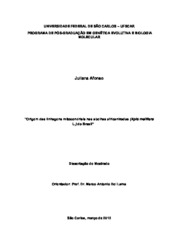Origem das linhagens mitocondriais nas abelhas africanizadas (Apis mellifera L.) do Brasil
Abstract
The Africanization process of Apis mellifera has raised several questions about the genetic makeup of resulting populations. This study aimed to identify the number, frequency and distribution of different mitochondrial haplotypes, as well as their origin in Africanized colonies sampled in different regions of the country. In this sense, 1626 colonies, 1048 from Brazil and the remaining from 12 other countries. Including samples from scutellata, iberiensis, and ligustica subspecies, Africanized and non-Africanized honeybees from South America and Central America were analyzed. Identification of patterns was done by PCR-RFLP of COI region with endonucleases BclI and TaqI, followed by sequencing of representative samples of these patterns. These results are then related to the patterns already described for COI-COII region of the same samples by Collet et al. (2206). Geographic association between observed electrophoretic patterns and the relationships among haplotypes allowed us to make certain inferences regarding geographical origin of these patterns. BclI generated three restriction patterns, designated 1, 2 and 3, while TaqI generated four restriction patterns, A, B, C and D. These patterns resulted in seven composite patterns formed by the association of patterns produced by the two nucleases in samples from Brazil. When previous data on the DraI restriction patterns of the intergenic region COI-COII were considered, 17 composite haplotypes were observed in those samples. Samples from Brazil, South Africa, Kenya, Portugal, Spain, Italy and Chile (n = 90) were submitted to sequencing reaction, generating 35 haplotypes and 13 different aminoacid sequences. Our data demonstrated that simple association of restriction patterns was not adequate to infer geographic origin of mitochondrial lineages in Africanized populations, a task which requires knowledge of their corresponding nucleotide sequences. It was possible to infer the origin of 11 of the 17 composite COI and COI-COII haplotypes found in samples from Brazil. COI patterns did not show a clinal distribution like the one observed with COI-COII patterns. Our data clearly indicates nucleotide and amino acid substitutions privative to European and African / Africanized samples, a matter that deserves subsequent research.
